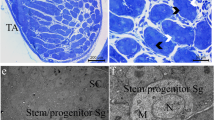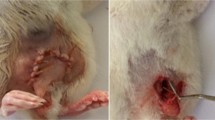Abstract
Background
Mammalian spermatogenesis is responsible for male fertility and is supported by the self-renewal and differentiation of spermatogonial stem cells (SSCs). Sertoli cells provide a supportive microenvironment for SSCs, in part by the production of stem cell factor (SCF), which is a potent regulator of spermatogonia proliferation and survival.
Methods
We investigated the novel role of β-estradiol in modulating the proliferation and apoptosis of fetal SSCs via the regulation of SCF secretion in Sertoli cells isolated from human fetal testes. The proliferation of SSCs in the co-culture system was determined by colony formation and BrdU incorporation assays. TUNEL assay was used to measure SSC apoptosis in co-culture in response to treatment with control, β-estradiol, or the combination of β-estradiol and the estrogen receptor inhibitor ICI 182780.
Results
In the system with purified human fetal Sertoli cells (MIS+/c-Kit−/AP−), β-estradiol upregulated the production of SCF in a dose- and time-dependent manner. In the co-culture system of primary human fetal SSCs (c-Kit+/SSEA-4+/Oct-4+/AP+) and Sertoli cells (MIS+), β-estradiol markedly increased the proliferation of SSCs. Moreover, SSC apoptosis was significantly inhibited by β-estradiol and was completely reversed by the combination of β-estradiol and ICI 182780.
Conclusion
Here we report, for the first time, that β-estradiol can induce the increase of SCF expression in human fetal Sertoli cells and regulates the growth and survival of human fetal SSCs. These novel findings provide new perspectives on the current understanding of the role of estrogen in human spermatogenesis.







Similar content being viewed by others
References
Phillips BT, Gassei K, Orwig KE. Spermatogonial stem cell regulation and spermatogenesis. Philos Trans R Soc Lond Ser B Biol Sci. 2010;365(1546):1663–78.
de Rooij DG. The spermatogonial stem cell niche. Microsc Res Tech. 2009;72(8):580–5.
Dadoune JP. New insights into male gametogenesis: what about the spermatogonial stem cell niche. Folia Histochem Cytobiol. 2007;45(3):141–7.
Kanatsu-Shinohara M, Miki H, Inoue K, Ogonuki N, Toyokuni S, Ogura A, et al. Germline niche transplantation restores fertility in infertile mice. Hum Reprod. 2005;20(9):2376–82.
Griswold MD. The central role of Sertoli cells in spermatogenesis. Semin Cell Dev Biol. 1998;9(4):411–6.
Cardoso HJ, Figueira MI, Correia S, Vaz CV, Socorro S. The SCF/c-KIT system in the male: survival strategies in fertility and cancer. Mol Reprod Dev. 2014;81(12):1064–79.
Allard EK, Blanchard KT, Boekelheide K. Exogenous stem cell factor (SCF) compensates for altered endogenous SCF expression in 2,5-hexanedione-induced testicular atrophy in rats. Biol Reprod. 1996;55(1):185–93.
Chojnacka K, Zarzycka M, Mruk DD. Biology of the Sertoli cell in the fetal, pubertal, and adult mammalian testis. Results Probl Cell Differ. 2016;58:225–51.
Altman E, Yango P, Moustafa R, Smith JF, Klatsky PC, Tran ND. Characterization of human spermatogonial stem cell markers in fetal, pediatric, and adult testicular tissues. Reproduction. 2014;148(4):417–27.
Baroni T, Arato I, Mancuso F, Calafiore R, Luca G. On the origin of testicular germ cell tumors: from gonocytes to testicular cancer. Front Endocrinol (Lausanne). 2019;10:343.
Mäkelä JA, Koskenniemi JJ, Virtanen HE, Toppari J. Testis development. Endocr Rev. 2019;40(4):857–905.
Carreau S, Bouraima-Lelong H, Delalande C. Estrogen, a female hormone involved in spermatogenesis. Adv Med Sci. 2012;57(1):31–6.
Robertson KM, O'Donnell L, Jones MEE, Meachem SJ, Boon WC, Fisher CR, et al. Impairment of spermatogenesis in mice lacking a functional aromatase (cyp 19) gene. Proc Natl Acad Sci U S A. 1999;96(14):7986–91.
Eddy EM, Washburn TF, Bunch DO, Goulding EH, Gladen BC, Lubahn DB, et al. Targeted disruption of the estrogen receptor gene in male mice causes alteration of spermatogenesis and infertility. Endocrinology. 1996;137(11):4796–805.
Hess RA. Estrogen in the adult male reproductive tract: a review. Reprod Biol Endocrinol. 2003;1:52.
Heldring N, Pike A, Andersson S, Matthews J, Cheng G, Hartman J, et al. Estrogen receptors: how do they signal and what are their targets. Physiol Rev. 2007;87(3):905–31.
Rago V, et al. Differential expression of estrogen receptors (ERalpha/ERbeta) in testis of mature and immature pigs. Anat Rec A Discov Mol Cell Evol Biol. 2004;281(2):1234–9.
Saunders PT, Sharpe RM, Williams K, Macpherson S, Urquart H, Irvine DS, et al. Differential expression of oestrogen receptor alpha and beta proteins in the testes and male reproductive system of human and non-human primates. Mol Hum Reprod. 2001;7(3):227–36.
Boukari K, Ciampi ML, Guiochon-Mantel A, Young J, Lombes M, Meduri G. Human fetal testis: source of estrogen and target of estrogen action. Hum Reprod. 2007;22(7):1885–92.
Gaskell TL, Robinson LLL, Groome NP, Anderson RA, Saunders PTK. Differential expression of two estrogen receptor beta isoforms in the human fetal testis during the second trimester of pregnancy. J Clin Endocrinol Metab. 2003;88(1):424–32.
Tu J, Fan L, Tao K, Zhu W, Li J, Lu G. Stem cell factor affects fate determination of human gonocytes in vitro. Reproduction. 2007;134(6):757–65.
Lakpour MR, Aghajanpour S, Koruji M, Shahverdi A, Sadighi-Gilani MA, Sabbaghian M, et al. Isolation, culture and characterization of human Sertoli cells by flow cytometry: development of procedure. J Reprod Infertil. 2017;18(2):213–7.
Guo Y, Hai Y, Gong Y, Li Z, He Z. Characterization, isolation, and culture of mouse and human spermatogonial stem cells. J Cell Physiol. 2014;229(4):407–13.
Liu S, Tang Z, Xiong T, Tang W. Isolation and characterization of human spermatogonial stem cells. Reprod Biol Endocrinol. 2011;9:141.
Chui K, Trivedi A, Cheng CY, Cherbavaz DB, Dazin PF, Huynh ALT, et al. Characterization and functionality of proliferative human Sertoli cells. Cell Transplant. 2011;20(5):619–35.
Mei XX, Wang J, Wu J. Extrinsic and intrinsic factors controlling spermatogonial stem cell self-renewal and differentiation. Asian J Androl. 2015;17(3):347–54.
Gunes S, Arslan MA, Hekim GNT, Asci R. The role of epigenetics in idiopathic male infertility. J Assist Reprod Genet. 2016;33(5):553–69.
Krausz C, Escamilla AR, Chianese C. Genetics of male infertility: from research to clinic. Reproduction. 2015;150(5):R159–74.
Mauduit C, Hamamah S, Benahmed M. Stem cell factor/c-kit system in spermatogenesis. Hum Reprod Update. 1999;5(5):535–45.
Fliss AE, Benzeno S, Rao J, Caplan AJ. Control of estrogen receptor ligand binding by Hsp90. J Steroid Biochem Mol Biol. 2000;72(5):223–30.
Levin ER. Plasma membrane estrogen receptors. Trends Endocrinol Metab. 2009;20(10):477–82.
Caneguim BH, Beltrame FL, da Luz JS, Valentini SR, Cerri PS, Sasso-Cerri E. Primordial germ cells (spermatogonial stem cells) of bullfrogs express sex hormone-binding globulin and steroid receptors during seasonal spermatogenesis. Cells Tissues Organs. 2013;197(2):136–44.
Oatley JM, Brinster RL. The germline stem cell niche unit in mammalian testes. Physiol Rev. 2012;92(2):577–95.
Moe-Behrens GH, et al. Akt/PTEN signaling mediates estrogen-dependent proliferation of primordial germ cells in vitro. Mol Endocrinol. 2003;17(12):2630–8.
Correia S, Alves MR, Cavaco JE, Oliveira PF, Socorro S. Estrogenic regulation of testicular expression of stem cell factor and c-kit: implications in germ cell survival and male fertility. Fertil Steril. 2014;102(1):299–306.
Schrans-Stassen BH, et al. Differential expression of c-kit in mouse undifferentiated and differentiating type A spermatogonia. Endocrinology. 1999;140(12):5894–900.
Morimoto H, Kanatsu-Shinohara M, Takashima S, Chuma S, Nakatsuji N, Takehashi M, et al. Phenotypic plasticity of mouse spermatogonial stem cells. PLoS One. 2009;4(11):e7909.
Zhang L, Tang J, Haines CJ, Feng H, Lai L, Teng X, et al. c-kit and its related genes in spermatogonial differentiation. Spermatogenesis. 2011;1(3):186–94.
Pesce M, Di Carlo A, De Felici M. The c-kit receptor is involved in the adhesion of mouse primordial germ cells to somatic cells in culture. Mech Dev. 1997;68(1-2):37–44.
Srihawong T, Kuwana T, Siripattarapravat K, Tirawattanawanich C. Chicken primordial germ cell motility in response to stem cell factor sensing. Int J Dev Biol. 2015;59(10-12):453–60.
Funding
This work was supported by the National Natural Science Foundation of China (No. 31472054), the National Key Research and Development Program of China (2016YFC1000600), the Natural Science Foundation of Hunan Province (No. 2018JJ3367), and the Scientific Research Foundation of Hunan Provincial Education Department (No. 18C0067).
Author information
Authors and Affiliations
Contributions
LQF and KT designed the study. YCC, YS, LX, and DZ supervised sample collection. KT, YS, and WBZ performed the experiments and data collection. LZL revised data analysis and figures preparation. All authors have participated in the manuscript preparation.
Corresponding author
Ethics declarations
Ethics approval
This study was approved by the Ethics Committee of the Reproductive & Genetic Hospital of CITIC-Xiangya, Basic Medical Science School, Central South University, Changsha, China.
Consent to participate
Oral and written informed consent was obtained from each participant.
Conflict of interest
The authors declare no competing interests.
Additional information
Publisher’s note
Springer Nature remains neutral with regard to jurisdictional claims in published maps and institutional affiliations.
Supplementary information
Fig. S1.
Identification of fetal SSCs and Sertoli cells in 20-week-old human fetal testes. Immunofluorescence analysis was performed on a cryosection of a 20-week-old human fetal testis. (a) Immunostaining of Oct4 (green); (b) immunostaining of MIS (green). The nuclei are stained with DAPI (blue). Scale bar: 50 μm. (PNG 267 kb)
Rights and permissions
About this article
Cite this article
Tao, K., Sun, Y., Chao, Y. et al. β-estradiol promotes the growth of primary human fetal spermatogonial stem cells via the induction of stem cell factor in Sertoli cells. J Assist Reprod Genet 38, 2481–2490 (2021). https://doi.org/10.1007/s10815-021-02240-y
Received:
Accepted:
Published:
Issue Date:
DOI: https://doi.org/10.1007/s10815-021-02240-y




